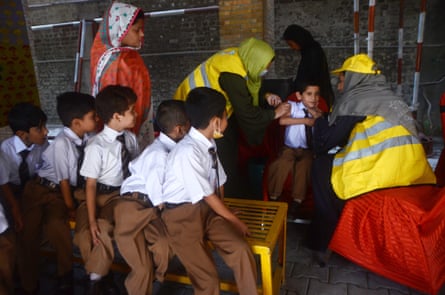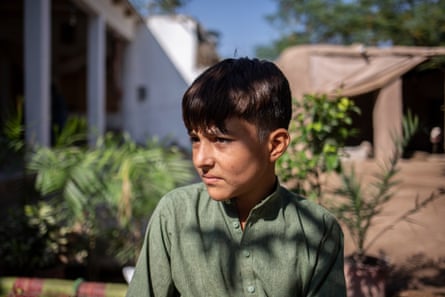‘Drug-resistant typhoid is the final warning sign’: disease spreads in Pakistan as antibiotics fail

From his sickbed, eight-year-old Ukasha could see his siblings play with a ball in the courtyard. His head hurt and his body felt too heavy to move. Ukasha had typhoid fever – an illness he should have recovered from in days. It had been a month.
At its worst, typhoid can kill. Ukasha’s family were anxious, even moving his bed outside to give him fresh air and sunlight. Now he could sit up, smile at the view in front of him and even finally eat his favourite food, eggs.
His classmate, 12-year-old AbuZar, had also been in bed for months with typhoid. At the height of the infection, he woke up in the middle of the night, burning hot and drenched in sweat.
Children across the village – on the outskirts of Peshawar, northern Pakistan – had been falling ill.
Typhoid, also known as enteric fever, is an infection caused by contaminated food or water. If left untreated, it kills one in five. But the cure is a simple course of antibiotics. Most people, if they get the drugs promptly, should start recovering within a few days.
But the antibiotics used to cure typhoid are now failing. The bacteria, Salmonella typhi, have developed resistance to the antibiotics meant to kill them. It’s a pattern repeated across the world; the problem of resistant infections is global and borderless.
When he fell sick, Ukasha’s father took him to Hayatabad Medical Complex, a hospital in Peshawar. Typhoid, which is contagious, was soon diagnosed.
The hospital was rammed. On the children’s ward, each single bed held four or five patients, so Ukasha’s father took him home for the rest of his treatment.
“Typhoid was once treatable with a set of pills and now ends up with patients in hospital,” says Jehan Zeb Khan, the clinical pharmacist at the hospital.
Ukasha’s infection was caused by extensively drug resistant (XDR) typhoid – a strain of “superbug” that emerged in Pakistan in 2016. XDR-typhoid is resistant to almost all of the antibiotics that are supposed to treat the disease, so options are limited and death rates are higher.
Of the roughly 9 million people who get sick from typhoid each year globally, the vast majority are infected by a drug-resistant strain. Pakistan has the worst rates in south Asia: more than 15,000 cases of XDR-typhoid have been officially reported in the country – and some outbreaks, like the one in Ukasha’s village, go unrecorded.
The risk of typhoid is higher where a community lacks safe water and sanitation. A neglected sewage system, for instance, can contaminate water and compound the problem.

Pakistan has one of the lowest rankings in the world for access to clean water near homes, and contaminated water is thought to be the cause of about 80% of diseases in the country.
“There is no reason we should have typhoid fever today if we have proper access to safe water and sanitation,” says Dr Maria Neira, a health director at the World Health Organization.
Ukasha’s father was convinced that a contaminated water tank in the boys’ school had led to the outbreak in their village. When the Bureau for Investigative Journalism contacted the school, it said that nothing had been reported.
“Access to safe water is one of the public health fundamentals that should not be denied to anyone,” Neira says. “Wherever you have a lack of hand hygiene and the [lack of] possibility in the healthcare facilities to wash your hands, you will see an overlap with cases of drug-resistant typhoid.
“Drug-resistant typhoid is unique in the challenge that it represents,” she adds. “It is preventable and it is very much related to poverty – the vulnerability of people, and lack of access to water and sanitation.”
Pakistan has vaccinated more than 30 million children against typhoid since 2019, but these efforts have been mostly concentrated in the south of the country, where XDR-typhoid first emerged. There are more than 100 million children in Pakistan, and the infection has spread north.
Laboratory testing was crucial to Ukasha’s recovery. The doctors were able to identify the strain causing the infection, which can be treated with only three antibiotics. The variant was resistant to all other antibiotics usually recommended for typhoid.

Ukasha needed meropenem – a “last-resort” drug reserved for the most serious illnesses. He was given 22 injections, two a day. Each jab took a significant financial toll on the family.
How did such an extensively drug-resistant typhoid strain emerge? Over time, bacteria are able to develop the ability to defend themselves against the antibiotics that are meant to kill them. The more the bacteria are exposed to antibiotics, the more this ability can spread.
Overuse of antibiotics is one of the biggest contributors to drug-resistant bacteria. Global consumption of antibiotics has increased by almost half between 2000 and 2018, with the greatest rises in countries in south Asia, such as Pakistan.
This overuse is in part down to typhoid having similar symptoms to malaria, dengue and Covid-19, all caused by viruses and microbes that cannot be fought with antibiotics. But if proper testing is not available, doctors may prescribe antibiotics “just in case”, particularly in places where access to healthcare is limited.
Rapid tests for typhoid can also throw up false positives. Without follow-up lab tests, the rapid tests can lead to overdiagnosis, and more patients being given pointless antibiotics.
Experts in Pakistan have gone so far as to blame these tests for driving cases of drug-resistant typhoid. Health authorities have banned the Typhidot and Widal rapid tests but they remain widely available.
When AbuZar was admitted to hospital, he was treated with azithromycin, one of the few antibiotics that still work against XDR-typhoid. However, doctors are now seeing strains of typhoid that no longer respond to it.

Superbugs are not confined within borders. Cases have been identified in 16 other countries, including in India, China, Qatar, the UK and US. The US Centers for Disease Control has warned all travellers to Pakistan to take precautions against the superbug.
This week, world leaders will meet at the UN in New York to address drug-resistant infections and to negotiate a political declaration for member states.
“XDR-typhoid is the final warning sign. After this we will enter a stage where the superbug won’t respond to any drugs at all. That means we will go back to when typhoid was a more deadly disease. And that really worries us,” Khan says.
In Pakistan, after their treatment, Ukasha and AbuZar both felt well enough to return to school. Within a few days, both had fevers again.
This article was produced in collaboration with, and with reporting from, the Bureau of Investigative Journalism
The Bill Gates Foundation, which contributes funding towards the independent journalism produced on the global development site, is also among the contributors to the typhoid vaccination programme referred to in this article
 Print
Print


